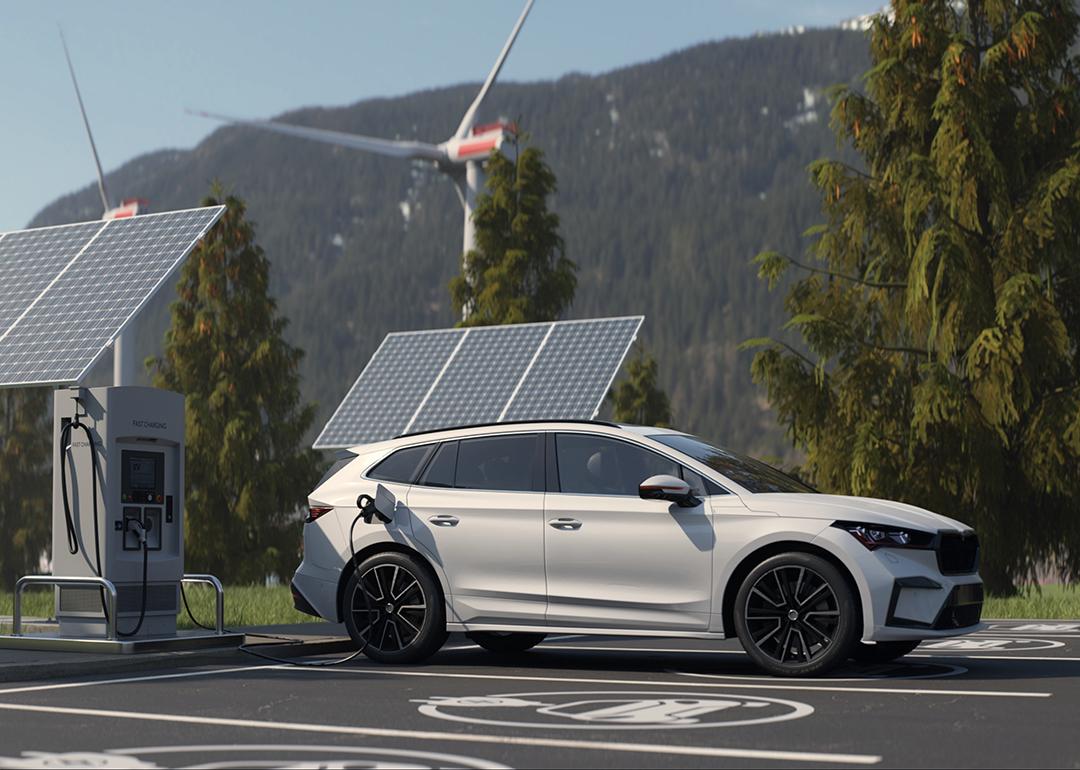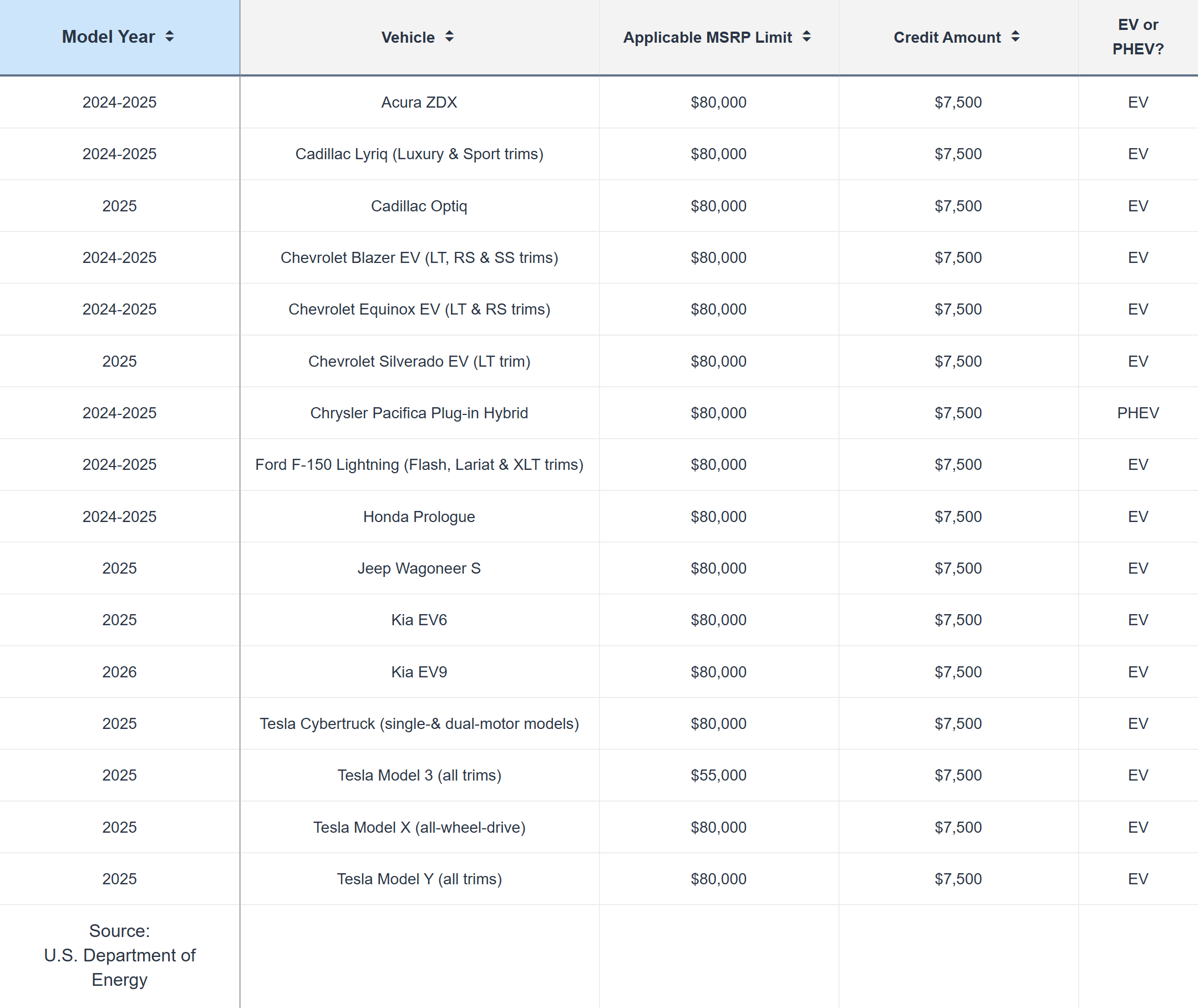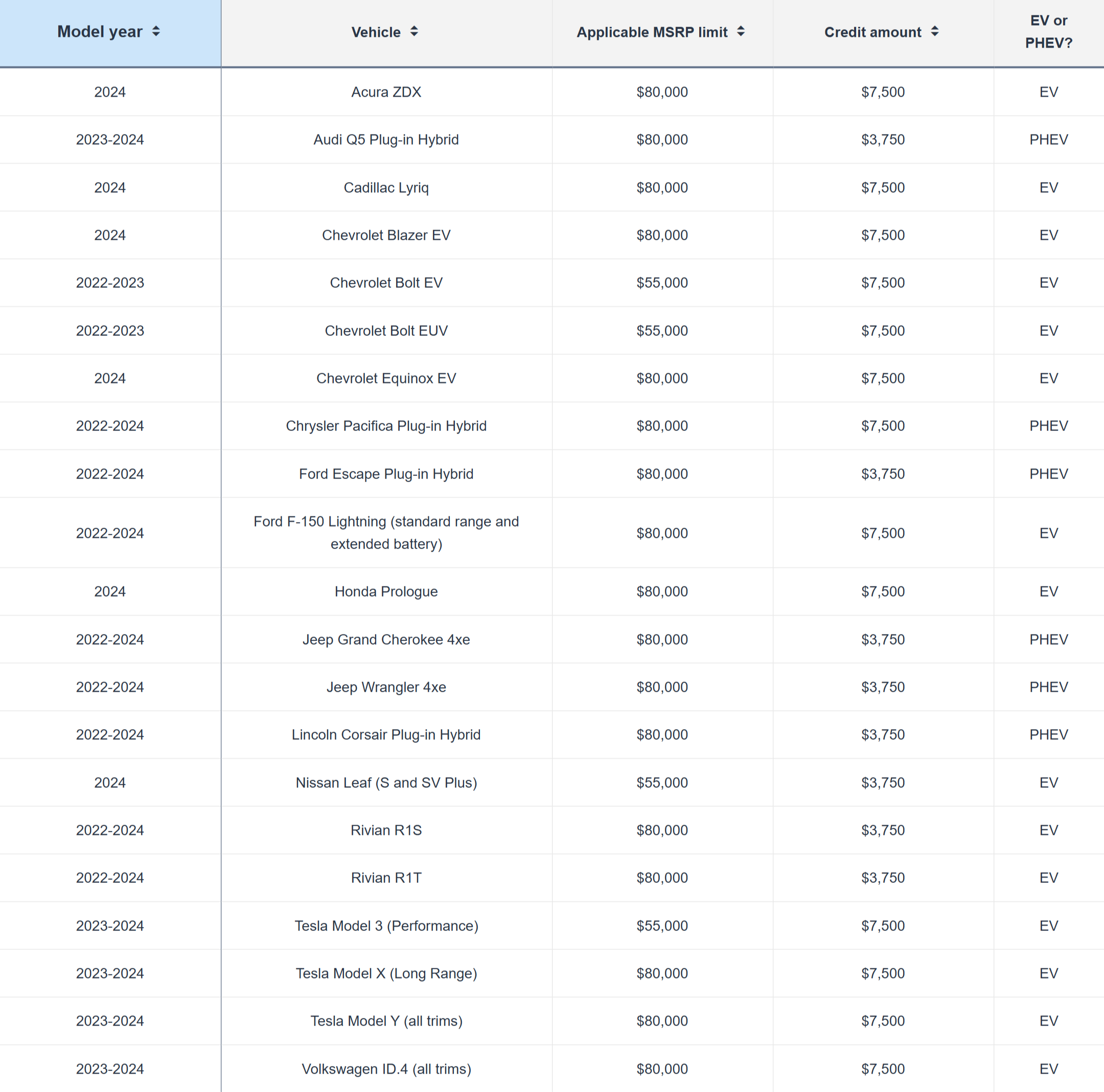
Electric vehicle tax credits 2024 and 2025: What you need to know
This story was produced by Edmunds and reviewed and distributed by Stacker.
Electric vehicle tax credits 2024 and 2025: What you need to know
Federal EV tax credits in 2024 top out at $7,500 if you're buying a new car and $4,000 if you're buying a used car, while the bank or the automaker's finance company can take a $7,500 tax credit for EV leases, but may discount your lease accordingly. If you want to skip the fine print, click here to jump straight to the full list of cars that qualify for an EV tax credit. Otherwise, Edmunds takes a quick look at the key rules for each scenario—buying new, buying used, and leasing—and then digs into the details.
If you're buying a new EV or PHEV (plug-in hybrid), the "final assembly" of the vehicle must have occurred in North America to unlock any tax credits. If it passes that test, now you're looking at two $3,750 electric car tax credits that add up to $7,500 if you meet all the criteria. To get the first $3,750 credit, a certain percentage of the car's critical battery minerals must have been sourced from the U.S. or from any country that has a free-trade agreement with the U.S. The other $3,750 credit requires that a certain percentage of battery components were manufactured or assembled in the same roster of countries. There are also significant eligibility caps on both the manufacturer's suggested retail price of the vehicle—$55,000 for cars; $80,000 for SUVs, trucks, and vans—and the income of the buyer, which is subject to limits between $150,000 and $300,000, depending on tax filing status. If either figure is too high, you won't qualify for any federal EV tax credits.
If you're buying a used EV or PHEV, you don't have to worry about where the car was assembled or where its battery bits came from. The income caps are significantly lower, however, ranging from $75,000 to $150,000, while the car itself must be at least two years old and cost no more than $25,000. You also have to buy it from a dealer, not a private party. Check all the boxes, and you can get a tax credit of up to $4,000, though there's a sliding scale for cheaper used EVs, which is explained below.
What about leasing a new EV or PHEV? As of this writing, there's a legislative loophole that lets the originator of the lease (typically the automaker's finance division) take the full $7,500 tax credit for a leased EV, irrespective of the final assembly, battery sourcing, and vehicle pricing requirements. It's up to each automaker to decide whether to pass these savings along in the form of more affordable leases, but keep in mind that you might get a hefty discount on a leased EV thanks to this loophole. That's true even if your income would disqualify you from getting the tax credit on a purchased EV—since you're not the one getting the tax credit in this case, your income is irrelevant.
Which New Vehicles Qualify for the Federal EV Tax Credit?
The following vehicles should qualify for the federal EV tax credit because they are assembled in North America and meet the critical minerals and battery component requirements.
It's also worth noting that the vehicle must be purchased for "original use" to qualify for the federal tax credit, meaning that it is for the taxpayer's use. You cannot buy the vehicle and then immediately resell it in hopes of getting the tax credit.
This list is based on data from the U.S. Department of Energy, last updated on January 14, 2025. It affects new cars placed in service from January 1 through December 31, 2025. The list will likely change to include more models in the coming months and years. Edmunds will strive to keep the list current as vehicle manufacturers continue to submit the applicable vehicle information to the relevant government agencies. For those who purchased a vehicle in 2024, the list of eligible vehicles is here.
If you're interested in other possible EV credits, rebates, and manufacturer incentives, take a look at the detailed list here.

How to Qualify for the Used EV Tax Credit
The tax credit for used EVs will be calculated based on either 30% of the vehicle's value or $4,000, whichever is less. As mentioned earlier, there are no assembly requirements or battery component percentages for used EVs and PHEVs. The rules for used EVs went into effect on January 1, 2023, and are as follows:
- Price limit for used vehicles: There is a hard eligibility ceiling at a sale price of $25,000 for all used EVs regardless of type.
- Income limits for used vehicles: As with new vehicles, the income limits are determined by modified adjusted gross income (MAGI). By filing status, the limits are as follows.
- Joint tax returns or surviving spouse: $150,000
- Head of household: $112,500
- Individual or any other filing status: $75,000
Other eligibility requirements for used EVs:
- The vehicle must be at least two model years older than the calendar year in which it was purchased.
- The used EV tax credit applies only once in the vehicle's lifetime. Subsequent owners are not eligible.
- Once a buyer has taken the federal used EV credit, they are not eligible for another credit for three years.
- The vehicle must be for personal use and "not for resale."
- The vehicle must be purchased through a dealer.
- Only an individual may claim the used EV tax credit. Businesses are excluded.
Electric Vehicle Tax Credit for Leasing
Leased electric cars or plug-in hybrids from dealerships are considered "commercial vehicles" under IRS regulations. This means that the full $7,500 tax credit goes to the company that leased it to you, which is usually the automaker's captive finance arm. In other words, the automaker itself effectively gets the benefit of the tax credit. Moreover, leased EVs and PHEVs are not subject to the major restrictions detailed above—there are no limitations regarding final assembly, battery sourcing, or vehicle pricing, while the caps on buyer income are irrelevant because there is no purchase in the case of a lease.
There's also no obligation on the automaker's part to pass along any savings to you, but in practice, many automakers seem to be offering at least some kind of discount on EV leases as a direct result of this loophole. It probably won't last forever, so if you're interested in leasing vehicles not on the list here, check with your local dealership to see if there are loophole-driven lease discounts.
How to Qualify for the Full $7,500 Federal Electric Vehicle Tax Credit
Several requirements will determine whether an electric car qualifies for the full $7,500 federal electric vehicle tax credit. The maximum buyer credit for new vehicles is $7,500, provided that several requirements are met. Click on any of the links below to jump to the information you're looking for, or keep scrolling to get all the details.
Final Assembly, Parts, and Mineral Sourcing Requirements
The final assembly of the new vehicle must occur in North America (i.e., the U.S., Canada, or Mexico). This is the gateway requirement for the federal EV tax credit—if the answer is no, the EV won't qualify (unless you're leasing; please see the leasing section for more details). This rule went into effect on August 16, 2022, and affects vehicles purchased through 2032.
If the vehicle meets the assembly requirement, you can think of the $7,500 federal EV tax credit as being split into two halves—critical battery minerals and battery components—each worth $3,750 and subject to requirements of its own. The EPA has already calculated the percentages below to determine which cars are eligible and are reflected in this list, so you won't have to figure it out yourself.
- Critical battery minerals: To qualify for this $3,750 credit, at least 60% of the critical minerals in the vehicle's battery must have been either recycled in the U.S. or extracted or processed there (or in any country with a free trade agreement with the U.S.). After that, the required percentage increases to 70% in 2026 and 80% in 2027.
- Battery components: To qualify for the remaining $3,750 credit, at least 60% of the EV's battery components must be manufactured or assembled in the U.S. (or in any country with a free-trade agreement with the U.S.). After that, the percentage increases to 70% in 2026, 80% in 2027, 90% in 2028 and 100% in 2029.
New Vehicle Pricing Limits for EV Tax Credits
The following price caps by vehicle type became effective as of January 1, 2023, and refer specifically to the manufacturer's suggested retail price, or MSRP. It does not include the manufacturer's destination charge, optional items added by the dealer, or taxes and fees. For example, if you're looking at an SUV with a $79,990 MSRP, and the destination fee takes it over $80,000, the vehicle is still eligible. If, for example, the vehicle is priced above the MSRP limit (let's say $82,000), but there's a manufacturer incentive that brings it back down to $80K, the vehicle would also not be eligible.
For SUVs, vans and pickup trucks, the eligible MSRP maximum is $80,000. For any other qualifying vehicle, the eligible MSRP maximum is $55,000.
New Car Buyer Income Limits for EV Tax Credits
The income limits are based on modified adjusted gross income, or MAGI, which is roughly the adjusted gross income with certain allowable deductions added back in for the current or prior tax year. Depending on your tax filing status, the limits for a new vehicle are:
- Joint tax returns or surviving spouse: $300,000
- Head of household: $225,000
- Individual or any other filing status: $150,000
What's Changed for 2025?
As of January 1, 2025, a vehicle is ineligible for a tax credit if any of the battery's components and critical battery materials were sourced from a "foreign entity of concern," which includes China, Iran, North Korea, and Russia. That's a big deal given China's outsized role in the minerals supply chain to date. The critical battery minerals requirement went up to 60% (from 50% last year). These added requirements have reduced the list of eligible vehicles until automakers can restructure their supply chains. We'll monitor this list and update this article as things change.
How Do I Claim the EV Tax Credit?
If you purchased an eligible vehicle in 2024 and onward, you have two options to claim the tax credit:
- You can claim the credit on your tax return for the year in which it was purchased, using Form 8936. If your tax liability is less than $7,500, the IRS said it will not seek repayment, but just keep in mind you won't get to keep the difference either, as it is a nonrefundable credit.
- You can transfer the EV tax credit to an eligible dealership so that they can apply the credit amount to your final purchase cost. The dealership must be registered with IRS Energy Credits Online. They should submit and give you a copy of the "time of sale report" to confirm that the report was accepted. This document will be needed when filing your tax return. If you lease the vehicle, the credit goes to the lessor and may be used to reduce the price of the lease if the leasing party chooses to do so. If you choose to go this route, please note that you still need to fill out IRS Form 8936, which reports your eligibility for the credit and your decision to transfer the credit to the dealer.
It is important to verify that you meet the income requirements listed above; otherwise, you may need to repay the IRS if your modified adjusted gross income is higher than the authorized limits.
List of 2024 Eligible Vehicles
Edmunds kept this list from last year for those who purchased an EV in 2024 and are looking to file their taxes soon. These are the vehicles that were eligible to qualify for up to a $7,500 tax credit.

FAQs
How does the EV charger tax credit work?
If you are installing an EV charger at your home, the federal credit is generally 30% of the charger's cost or $1,000, whichever is smaller. For those wanting to install an EV charger at a business or investment property, the credit is generally 30% of the charger's cost or $30,000, whichever is smaller. You can claim the EV charger tax credit the following year on your income taxes using IRS Form 8911. Some states may have additional incentives for installing an EV charger, so it's worth looking into this list maintained by the DOE. Your local utility company might also have incentives for installing an EV charger.
How much can you write off for an electric car?
Technically, a write-off is a tax deduction, whereas the federal EV tax credit of up to $7,500 is just that—a tax credit. The difference is that a $7,500 write-off reduces your taxable income by that amount before the tax is calculated, whereas a $7,500 credit means you pay $7,500 less in tax than you would have otherwise. In case that didn't clear things up, just remember that for a given dollar amount, a tax credit means a lot more money in your pocket than a write-off. The maximum federal tax credit of $7,500 on an eligible electric vehicle is effectively a $7,500 handout to you, which is far more than what you'd gain if you simply subtracted $7,500 from your taxable income. It's also worth looking into this list of state EV incentives maintained by the DOE so that you can maximize the benefits of buying an EV. From 2024 onward, you'll also have the option to transfer your federal EV tax credit to a qualified selling dealer and receive the amount of the credit as a discount on the car.
How does the federal tax credit for EVs work?
To qualify for the full $7,500 federal EV tax credit, the EV you purchase has to be brand-new and assembled in North America. Beyond that, increasingly stringent geographical requirements are being phased in regarding the composition and production of the car's battery pack alongside the vehicle pricing and personal income requirements. Read the full article for the latest details. From 2024 onward, you have the option of transferring your federal EV tax credit to a qualified selling dealer and receiving the amount of the credit as a discount on the car, as opposed to having to wait for tax season. You can also choose to have the credit applied to your taxes using IRS Form 8936, which you submit as part of your annual taxes to the federal government.
Are there tax credits from states or other sources?
Yes. While the federal tax credits for plug-in and natural gas vehicles get the most mention, there also are dozens of state and regional incentives on plug-in vehicles and those that use alternative fuels. Many states have a dozen or more programs. Many, however, apply only to businesses. Some credits come in the form of exemptions from fees and inspections. Others are nonmonetary incentives such as carpool lane access and free parking.
Retail buyers in a number of states can get some cost relief in the form of tax credits, rebates, reduced vehicle taxes, or registration fees for buying a qualified alternative-fuel or electric-drive vehicle. Edmunds keeps a detailed list of state, local, federal and manufacturer incentives all in one place. The U.S. Department of Energy also has an interactive chart of state incentives. It's a good idea to be sure about available state and local incentives before you shop. Just because a state has a program now doesn't mean it will continue indefinitely.
How about hydrogen fuel cell cars?
On paper, hydrogen fuel cell electric vehicles should qualify for incentives and are explicitly mentioned in the Inflation Reduction Act. However, at the time of this writing, no hydrogen-powered vehicles qualify for a tax credit for a vehicle purchase, likely due to not being built in North America. A work-around would be to lease the vehicle, in which case the automaker can—but is not obligated to—use the tax credit as a discount toward the lease. This can be a way to save some money on vehicles like the Toyota Mirai or Hyundai Nexo. Take a look at the U.S. Department of Energy's website to see the latest hydrogen laws and incentives.
Is there a tax credit for buying a Tesla in 2025?
Yes. As of the beginning of 2023, Tesla customers are once again eligible for the new tax credit of up to $7,500. That said, the vehicle must satisfy the manufacturing, pricing, and income requirements discussed in this article.
Note: President Donald Trump signed an executive order on January 20, 2025, with the aim of eliminating "the 'electric vehicle (EV) mandate.'" As of the publication date, the federal electric vehicle tax credit remains in effect.



